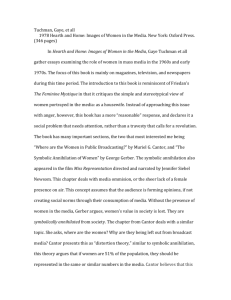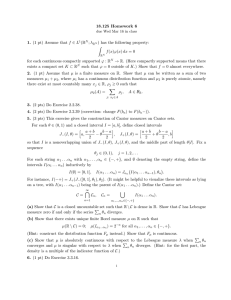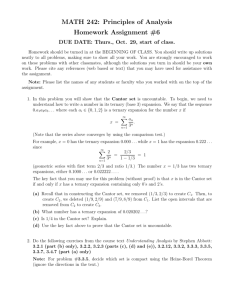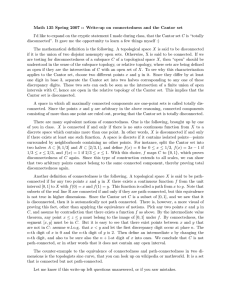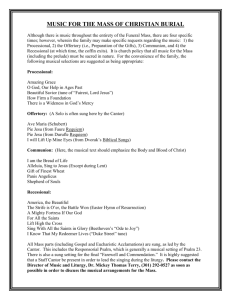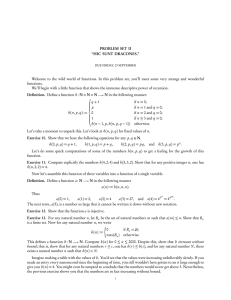Cantor aperiodic systems and Bratteli diagrams Konstantin Medynets
advertisement
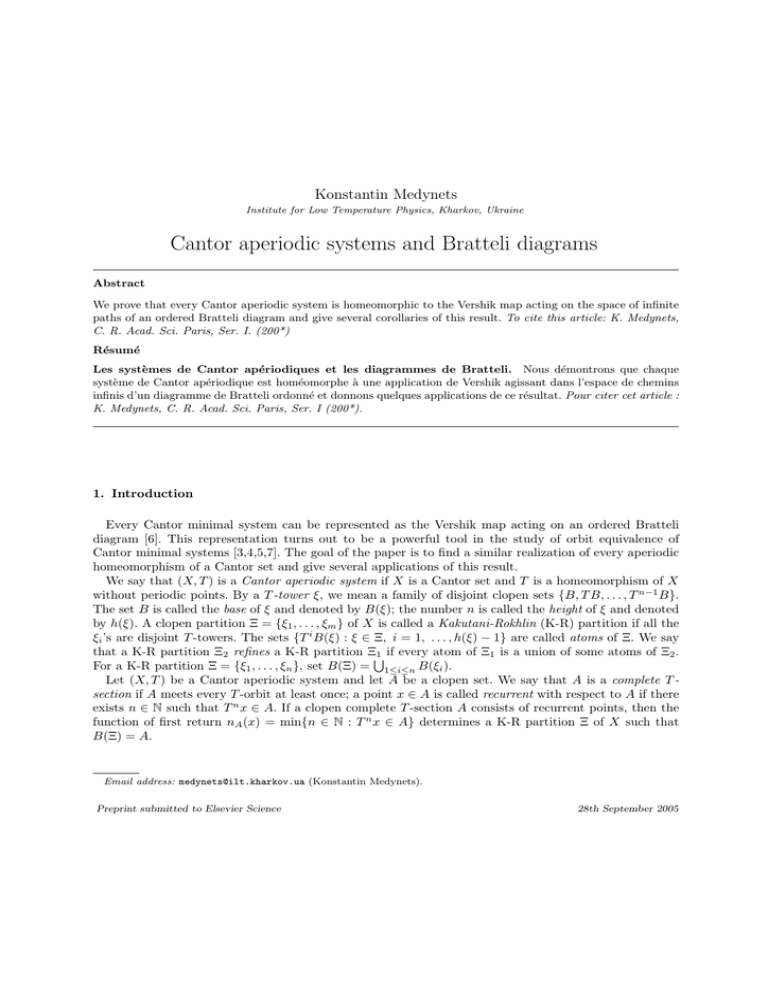
Konstantin Medynets
Institute for Low Temperature Physics, Kharkov, Ukraine
Cantor aperiodic systems and Bratteli diagrams
Abstract
We prove that every Cantor aperiodic system is homeomorphic to the Vershik map acting on the space of infinite
paths of an ordered Bratteli diagram and give several corollaries of this result. To cite this article: K. Medynets,
C. R. Acad. Sci. Paris, Ser. I. (200*)
Résumé
Les systèmes de Cantor apériodiques et les diagrammes de Bratteli. Nous démontrons que chaque
système de Cantor apériodique est homéomorphe à une application de Vershik agissant dans l’espace de chemins
infinis d’un diagramme de Bratteli ordonné et donnons quelques applications de ce résultat. Pour citer cet article :
K. Medynets, C. R. Acad. Sci. Paris, Ser. I (200*).
1. Introduction
Every Cantor minimal system can be represented as the Vershik map acting on an ordered Bratteli
diagram [6]. This representation turns out to be a powerful tool in the study of orbit equivalence of
Cantor minimal systems [3,4,5,7]. The goal of the paper is to find a similar realization of every aperiodic
homeomorphism of a Cantor set and give several applications of this result.
We say that (X, T ) is a Cantor aperiodic system if X is a Cantor set and T is a homeomorphism of X
without periodic points. By a T -tower ξ, we mean a family of disjoint clopen sets {B, T B, . . . , T n−1 B}.
The set B is called the base of ξ and denoted by B(ξ); the number n is called the height of ξ and denoted
by h(ξ). A clopen partition Ξ = {ξ1 , . . . , ξm } of X is called a Kakutani-Rokhlin (K-R) partition if all the
ξi ’s are disjoint T -towers. The sets {T i B(ξ) : ξ ∈ Ξ, i = 1, . . . , h(ξ) − 1} are called atoms of Ξ. We say
that a K-R partition Ξ2 refines a K-R partition ΞS
1 if every atom of Ξ1 is a union of some atoms of Ξ2 .
For a K-R partition Ξ = {ξ1 , . . . , ξn }, set B(Ξ) = 1≤i≤n B(ξi ).
Let (X, T ) be a Cantor aperiodic system and let A be a clopen set. We say that A is a complete T section if A meets every T -orbit at least once; a point x ∈ A is called recurrent with respect to A if there
exists n ∈ N such that T n x ∈ A. If a clopen complete T -section A consists of recurrent points, then the
function of first return nA (x) = min{n ∈ N : T n x ∈ A} determines a K-R partition Ξ of X such that
B(Ξ) = A.
Email address: medynets@ilt.kharkov.ua (Konstantin Medynets).
Preprint submitted to Elsevier Science
28th September 2005
2. Bratteli diagrams
In this section, we show that every Cantor aperiodic system is homeomorphic to the Vershik map acting
on the space of infinite paths of an ordered Bratteli diagram.
Theorem 1 Let (X, T ) be a Cantor aperiodic system. There exists a sequence of K-R partitions {Ξn }
of X such that for all n ≥ 1 : (i) Ξn+1 refines Ξn ; (ii) hn+1 > hn , where hn = min{h(ξ) : ξ ∈ Ξn }; (iii)
B(Ξn ) ⊃ B(Ξn+1 ); (iv) the sequence {Ξn } generates the clopen topology of X.
The proof is obtained by consequent application of the following lemma. Note that part (ii) was originally proved in [1].
Lemma 2 Let (X, T ) be a Cantor aperiodic system.
(i) If A is a clopen complete T -section, then A consists of recurrent points.
(ii) For every n > 0, there exists a clopen K-R partition Ξ = {ξ1 , . . . , ξn } of X such that the height of
every T -tower h(ξi ) is at least n.
Proof. Since statement (ii) is principal, we sketch its proof. For every x ∈ X, find a clopen neighborhood
Ux such that T i Ux ∩ Ux = ∅ for i = 1, . . . , n − 1. Choose a finite subcover X = U1 ∪ . . . ∪ Uk , where
Ui = Uxi , i = 1, . . . , k. Set A1 = U1 and
Am = Um −
n−1
[
T j (A1 ∪ . . . ∪ Am−1 ),
m = 2, . . . , k.
j=−(n−1)
Notice that A = A1 ∪ . . . ∪ Ak is a clopen complete T -section. By (i), the set A consists of recurrent
points. To find Ξ, we apply the function of first return to A.
¤
Let (X, T ) be a Cantor system, we say that a closed nowhere dense set Y ⊂ X is a basic set if every
clopen neighborhood of YTis a complete T -section. If a sequence of K-R partitions {Ξn } satisfies conditions
of Theorem 1, then Y = n B(Ξn ) is a basic set. Thus,
Corollary 3 Every Cantor aperiodic system has a basic set.
For the notions related to ordered Bratteli diagrams we refer the reader to [3,6]. We recall only the
definition of the Vershik map: let B = (V, E, ≥) be an ordered Bratteli diagram with the path space
XB and let Xmax , Xmin be the sets of all maximal and minimal paths, respectively. We say that a
homeomorphism ϕB : XB → XB is a Vershik map if ϕB (Xmax ) = Xmin and if x = (x1 , x2 , . . .) ∈
/ Xmax ,
then ϕ(x1 , x2 , . . .) = (x01 , . . . , x0k−1 , xk , xk+1 , xk+2 , . . .), where k = min{n ≥ 1 : xn is not maximal}, xk is
the successor of xk , and (x01 , . . . , x0k−1 ) is the minimal path connecting the top vertex v0 with the range
of xk−1 . We call the system (XB , ϕB ) a Bratteli-Vershik model.
Let Y be a basic set for a Cantor aperiodic system
(X, T ). Take a sequence of K-R partitions {Ξn }
T
satisfying conditions of Theorem 1 such that Y = n B(Ξn ). Applying the method used in [6, Section 4]
to {Ξn }, we prove:
Theorem 4 Let (X, T, Y ) be a Cantor aperiodic system with a basic set Y . There exists an ordered
Bratteli diagram B = (V, E, ≥) such that (X, T ) is homeomorphic to a Bratteli-Vershik model (XB , ϕB )
and the homeomorphism complementing the conjugacy between T and ϕB maps the basic set Y onto the
set of all minimal
T paths of XB . The equivalence class of the diagram B does not depend on a choice of
{Ξn } such that n B(Ξn ).
It is interesting to describe the variety of Bratteli diagrams corresponding to Cantor aperiodic systems.
In other words, the question is whether a given Bratteli diagram has an ordering such that the Vershik
map is well-defined aperiodic homeomorphism. For minimal homeomorphisms the problem is solved as
follows: every Cantor minimal system is homeomorphic to a Bratteli-Vershik model acting on a simple
Bratteli diagram and vice versa every simple Bratteli diagram can be endowed with an ordering so that
the Vershik map is well-defined and minimal [6]. The following proposition gives a particular solution of
the above problem.
2
Proposition 5 Let B = (V, E) be a Bratteli diagram such that every cofinal class is infinite and let G
be a locally finite group generating the cofinal equivalence relation on the path space of B. Suppose G has
only one minimal component. Then there exists an ordering on B that admits the well-defined aperiodic
Vershik map.
Notice that if the group G in Proposition 5 has two minimal components, then a continuous Vershik map
may not exist. For example, any ordering on the following diagram do not define a continuous Vershik
map.
s
´Q
´
Q
s¡
¤´
¤s¡ Q¤s¡
Q
´
Q
´
£¤s¡¢ Q¤£s´
¡¢
¤£s¡¢
Q
´
Q
´
£s¢ Q£s´
¢
£s¢
ppppppppppppppp
3. Applications
Having represented a Cantor aperiodic system as the Vershik map on an ordered Bratteli diagram, we
can apply the technique of Bratteli diagrams developed in [3,4,5,6] to explore properties of the system.
In this section, we generalize some results of [3,4] to aperiodic homeomorphisms with a finite number of
minimal components.
Given a Cantor aperiodic system (X, T ), denote by CT the set of minimal T -components and set
N (T ) = min{card(Y ) : Y is a basic set}.
Proposition 6 (i) N (T ) is an invariant of orbit equivalence.
(ii) card(CT ) ≤ N (T ).
(iii) If card(CT ) < ∞, then card(CT ) = N (T )
The following proposition shows that Bratteli diagrams associated to aperiodic homeomorphisms with
a finite number of minimal components can be chosen to be ”almost” simple.
Proposition 7 Let (X, T ) be a Cantor aperiodic system such that N (T ) < ∞. Then (X, T ) can be
represented as the Vershik map acting on the path space of an ordered diagram B so that B has exactly
N (T ) simple invariant (with respect to the cofinal equivalence relation) subdiagrams and each of these
subdiagrams has a unique maximal and minimal path.
Proposition 7 allows us to generalize some results proved earlier for Cantor minimal systems to the
case of aperiodic homeomorphisms with a finite number of minimal components.
The following proposition generalizes Theorem 4.18 of [4]. Recall that an equivalence relation on a
Cantor set is said to be affable if it is homeomorphic to the cofinal equivalence relation on a Bratteli
diagram (for details see [4]).
Proposition 8 If (X, T ) is a Cantor aperiodic system such that N (T ) < ∞, then the equivalence relation
RT on X generated by the orbits of T is affable.
Given two equivalence relations E and F on Cantor sets X and F respectively, we say that E is
embeddable into F , in symbols E v F , if there is a continuous injection f : X → Y such that xEy iff
f (x)F f (y). And E and F are bi-embeddable if E v F and F v E. An equivalence relation is called
aperiodic if each equivalence class is infinite. The notion of bi-embeddability was originally considered in
[2] for countable Borel equivalence relations.
Theorem 9 Any two aperiodic affable equivalence relations are bi-embeddable.
The idea of the proof. If we have two aperiodic Bratteli diagrams B1 and B2 , i.e. every cofinal class is
infinite, then by appropriate telescoping and microscoping (for the definitions see [3]) of B1 , we can see
B2 as a subdiagram of B1 and vice versa.
¤
3
Consider a Cantor aperiodic system (X, T ) with a basic set Y . Let C(X, Z) be the group of continuous
functions from X to Z. Set C(X|Y, Z) = {f ∈ C(X, Z) : f |Y ≡ const} and ∂T f = f ◦T −f for f ∈ C(X, Z).
Denote by K 0 (X|Y, T ) the group C(X, Z)/∂T C(X|Y, Z), which is called a relative dimension group of
(X, T, Y ) [5]. Denote by K 0 (X|Y, T )+ and u0 the image of the positive cone {f ∈ C(X, Z) : f ≥ 0} and
1 in the quotient group K 0 (X|Y, T ), respectively.
Remark. If a basic set Y is a singleton, then K 0 (X|Y, T ) = C(X, Z)/∂T C(X, Z) and we denote this
group by K 0 (X, T ).
The proof of the following proposition is based on Proposition 5.2 of [5].
Proposition 10 Let (X, T ) be a Cantor aperiodic system with a basic set Y .
(i) The relative dimension group (K 0 (X|Y, T ), K 0 (X|Y, T )+ ) is an ordered group and u0 is an order unit.
(ii) For every Bratteli diagram B = (V, E) associated to the basic set Y , the dimension group K0 (V, E)
of the diagram B (for the definition see [3,6]) is isomorphic (as an ordered dimension group with order
unit) to K 0 (X|Y, T ).
The correspondence between a dimension group of a Cantor dynamical system and the dimension group
of the associated Bratteli diagram allows us to generalize Theorem 2.1 of [3].
Corollary 11 Let (X, T ) and (Y, S) be Cantor aperiodic systems such that N (T ) = N (S) = 1. Then
T and S are strong orbit equivalent if and only if K 0 (X, T ) and K 0 (Y, S) are isomorphic (as ordered
dimension groups with order units).
The sketch of the proof. We notice only that if K 0 (X, T ) ∼
= K 0 (Y, S), then the unordered Bratteli diagrams
constructed for homeomorphisms T and S by single-point basic sets are equivalent. To finish the proof
we apply the arguments of Theorem 1.1 of [5] or Theorem 2.1. of [3].
¤
References
[1] S. Bezuglyi, A.H. Dooley, and K. Medynets, The Rokhlin lemma for homeomorphisms of a Cantor set, Proc. Amer.
Math. Soc., to appear.
[2] R. Dougherty, S. Jackson, and A.S. Kechris, The structure of hyperfinite Borel equivalence relations, Trans. of Amer.
Math. Soc. v.341. No. 1, (1994), 193-225.
[3] T. Giordano, I. Putnam, and C. Skau, Topological orbit equivalence and C ∗ -crossed products, J. reine angew. Math.
469 (1995), 51-111.
[4] T. Giordano, I. Putnam, and C. Skau, Affable equivalence relations and orbit structure of Cantor dynamical systems,
Ergod. Th. and Dynam. Sys., to appear.
[5] E. Glasner and B. Weiss, Weak orbit equivalence of Cantor minimal systems, Int. J. Math. 6 (1995), No 4, 559-579.
[6] R.H. Herman, I. Putnam, and C. Skau, Ordered Bratteli diagram, dimension groups, and topological dynamics, Intern.
J. Math. 3 (1992), 827-864.
[7] H. Matui, Topological orbit equivalence of locally compact Cantor minimal systems, Ergod. Th. and Dynam. Sys. 22
(2002), No 6, 1871-1903.
4
